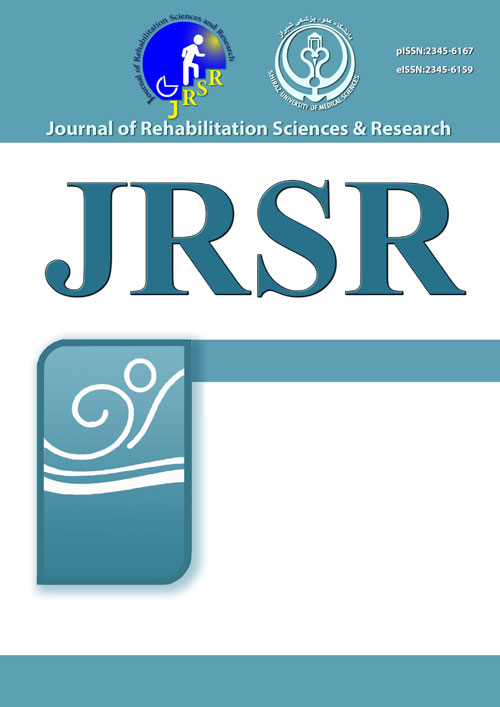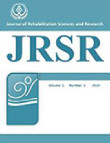فهرست مطالب

Journal of Rehabilitation Sciences and Research
Volume:1 Issue: 3, Sep 2014
- تاریخ انتشار: 1393/10/12
- تعداد عناوین: 5
-
Pages 47-51BackgroundThe objectives of this study were to compare manual dexterity (gross and fine) and coordination performance of the ipsilateral upper extremity of the right hemisphere stroke patients with the same side of a healthy group, and to determine the relationship of ipsilateral upper extremity dexterity and disability.MethodsIn a non-randomized analytical study, 30 individuals with a unilateral first-ever stroke from outpatient rehabilitation clinics and 30 age and sex-matched adults without history of neurological disorders were enrolled. Purdue Pegboard, Box and Block, and Finger to Nose tests were used to measure dexterity (fine and gross) and coordination performance of the stroke group compared with the same hand of the healthy group. The Barthel index was also used to assess disability or dependency of stroke patients in basic activities of daily living.ResultsResults showed that stroke individuals with involvement of ipsilateral hand had less coordination and dexterity when compared to the same hand of normal subjects (P=0.001). In addition, the relationship of gross and fine manual dexterity performance of the ipsilateral upper extremity with disability, including dependence in basic activities of daily living, were significant respectively (r=0.376, r= 0.391).ConclusionPeople with right stroke had significant ipsilateral upper extremity impairments (manual dexterity and coordination tasks), and this hand dexterity deterioration had an impact on their dependence in basic activities of daily living.Keywords: Coordination Impairment, Upper exterimity dexterity, Post, stroke
-
Pages 52-55BackgroundSince most clinical treatments of Persian children’s language impairments are based on either the therapist, clinicians’ experiences (mostly), or English language norms (sometimes), comparing two minor indices of speech quality, namely “mean Length of Utterance” (MLU) and “mean length of five phrasal utterances” (MLFPU) between different age groups of children, would be unequivocally efficient to help diagnose and treat Farsi-Speaking Children with language impairments.MethodsTo compare the two mentioned indices of 2 to 5-year-old normal Farsi-speaking children, the speech samples of 500 children were scrutinized by elicitation, transcription, and statistically analyzing their language samples.ResultsThe net results prove that as the children’s ages grow from 2 to 5, the two mentioned indices increase and extend as well.ConclusionThe influence of chronological age on the indices varies, regarding the type of language samples. Hence, the analysis of speech quality indices in assessment of children’s language ability has to be performed based on the language sampling methods.Keywords: Speech quality indices, richness of vocabulary, mean length of utterance, mean length of phrasal utterances
-
Pages 56-62BackgroundUniversity staff plays an important role in breeding a healthy and prosperous generation. Their right for attending to interests and selfactualization are noticeable. This qualitative research has been conducted in order to understand and explain the perspective and experience of staff working at Ahvaz Jundishapur University of Medical Sciences (AJUMS) about Leisure time.MethodsA qualitative study using purposeful sampling was performed among staff working in all parts of AJUMS about leisure time in 2012. The tool used for gathering data was a deep, semi-structured interview. Data saturation was achieved with 18 interviews. Findings from the interviews were analyzed using conventional content analysis.ResultsIn this study, there were 5 themes for perspective and experience of staff, including meaningfulness and purposefulness of leisure time (physical, mental and social), leisure time activities (passing individual and in group), leisure time duration (more or less, and the same as the time of working), barriers for leisure time (personal, social, and environmental), and suggestions for how to spend leisure time (role of the person and community). The findings from participants’ views and experiences showed that they are not satisfied with their leisure pattern. With attention to working at university, they do not have efficient leisure time duration.ConclusionParticipants believed that leisure time is effective to improve their physical, psychological, and social performance. People spend their leisure time either individually or in groups. Personal, social, and environmental barriers highlight the role of an individual and society as a whole in increasing opportunities for better leisure.Keywords: leisure, university, qualitative research, content analysis
-
Pages 63-66BackgroundHeat therapy is one of the natural treatments that can affect the information transferred by the proprioceptive receptors. Heat has an effect on the conduction velocity of peripheral nerves, but the exact effect of two kinds of deep and superficial heat on the joint position sense is not known clearly. The present study aimed to compare the effect of deep and superficial heat on ankle joint position sense.MethodsThirty healthy male students aged between 18 to 30 y/o participated in this study. Deep heat by short-wave diathermy and superficial heat by water of 42 ºC were applied for 15 minutes in two sessions for all participants. In all of the tests, active and passive ankle joint position sense in dorsiflexion and plantarflexion were measured by pedal goniometers prior to and after heat application. The Non-Parametric-Paired T-test Wilcoxon and Non-Parametric- Paired T-test Mann-Withney were used to analyze the data.ResultsThe superficial heat does not have any positive or negative effect on the ankle joint position sense. After the deep heat, the absolute angular error of active dorsiflexion was increased, but passive plantarflexion was decreased significantly. Comparing the two types of heat, the results revealed that the deep heat increased the absolute angular error of active dorsiflexion significantly more than superficial heat.ConclusionAccording to the results, deep heat therapy improves passive ankle joint position sense in plantar flexion, but it worsens the active joint position sense of dorsiflexion. Therefore, it seems that after applying deep heat therapy on an ankle joint, exercise prescriptions need to be cautious.Keywords: Deep Heat, Superficial Heat, Joint Position Sense
-
Pages 67-71BackgroundJoint position sense (JPS) is comprised of sensory input from several sources, including skin, joint capsule/ligaments, and muscular receptors. If the muscle receptors play a leading role in detecting joint position awareness, then muscle fatigue might yield a declination in JPS. The aim of this study was to evaluate if a sustained fatiguing contraction of the tibialis anterior (ankle dorsiflexor) could alter the ankle JPS.MethodsThis was a cross-sectional study in which 40 healthy subjects (age, 23.9±2.3 years; height, 172.6±5.7 cm; weight, 67.8±4.7 kg) were recruited. Subjects were asked to recognize 2 pre-recognized positions (10° in dorsiflexion (DF) and 21° in plantarflexion (PF)) for 2 experimental conditions: normal and fatigued. Muscular fatigue was induced in the tibialis anterior of the dominant leg by using an isometric test. The average of the absolute angular error (AAE) deviations from the target positions of three trials were recorded as scores for both fatigue and non-fatigue conditions.ResultsThere was significant decrease in subjects’ abilities to recognize active and passive repositioning of their ankle after a fatigue protocol (P=0.0001).ConclusionThe acuity of the ankle JPS is reduced subsequent to a fatigue protocol.Keywords: Joint position sense, Fatigue, Ankle, Weight bearing activity


